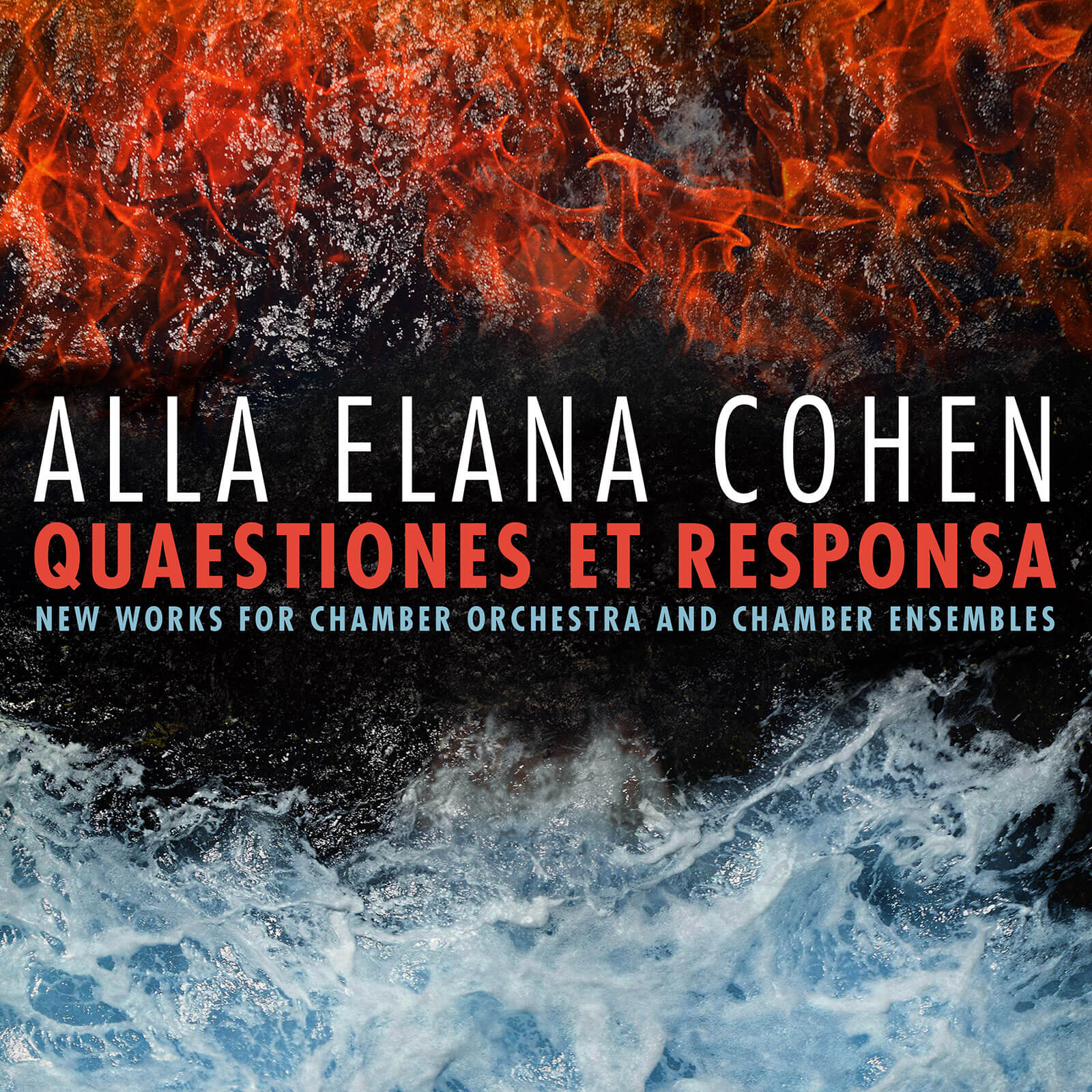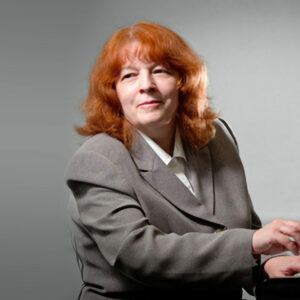
Share Album:
Quaestiones Et Responsa
Alla Elana Cohen composer
In celebration of her 30th anniversary of coming to America, Boston based composer Alla Cohen presents a double album of new works for chamber orchestra and chamber ensembles. A graduate of highest honors of the famed Moscow Conservatory, Cohen emigrated to the United States in 1989, first teaching at the New England Conservatory of Music, and for the last 15 years— as a Professor at Berklee College of Music. Her works have been awarded multiple prizes, are raved about in stellar reviews, and have been performed by acclaimed musicians from around the world.
Corresponding with Cohen’s monumental milestone of three decades in the United States as a highly acclaimed composer and sought-after master composition teacher, QUAESTIONES ET RESPONSA is a monumental release. This double album set, compiling Cohen’s recent compositions, very likely will be met with the same acclaim as her previous releases. Cohen’s music is strikingly unique by its style, monumental in scale, yet delicately crafted in every detail. The music is moving and uplifting, emotionally and spiritually, and is visionary and highly imaginative. These are the works of a dedicated master composer whose work and teaching captures the spirit of 20th and 21st-century art music. Cohen’s music is thought through, with painstaking care, yet retains a sense of being unbridled; often, the seemingly more traditional titles (like Partita) completely belie expectations – Cohen expands formal presumptions considerably and takes listeners on a journey to new lands of originality, discovery, and artistic freedom.
Notably, Cohen prides herself on performing her own parts at the piano – and justly so, for who could understand and execute Cohen’s thoughts better than the thinker herself? Hence, all the piano parts on QUAESTIONES ET RESPONSA are played by Cohen, who shines in this respect with empathetic sensitivity and impeccable timing; a skill she undoubtedly passes on to and demands from her other performers.
QUAESTIONES ET RESPONSA is a double album perfectly suited to the distinguished, educated contemporary music fancier. Defying conjectures and conventions, it is nothing less than confident, resolute sophistication, just as Cohen herself. Her music will also appeal to all those who are interested in the directions of art music today.
Listen
Stream/Buy
Choose your platform
Track Listing & Credits
| # | Title | Composer | Performer | |
|---|---|---|---|---|
| DISC ONE | ||||
| 01 | Partita for Chamber Orchestra: I. Preamble | Alla Elana Cohen | Elzbieta Brandys, flute; Izumi Sakamoto, oboe; Alexis Lanz, clarinet; Eric Huber, vibraphone; Timur Rubinshteyn, tambourine & tambour; Thomas Schmidt, marimba; Marissa Licata, 1st violin; Emily Rome, 2nd violin; Ervin Dede, viola; Sebastian Bäverstam, cello | 2:51 |
| 02 | Partita for Chamber Orchestra: II. Nightingale and Rose | Alla Elana Cohen | Elzbieta Brandys, flute; Izumi Sakamoto, oboe; Alexis Lanz, clarinet; Eric Huber, vibraphone; Timur Rubinshteyn, tambourine & tambour; Thomas Schmidt, marimba; Marissa Licata, 1st violin; Emily Rome, 2nd violin; Ervin Dede, viola; Sebastian Bäverstam, cello | 2:26 |
| 03 | Partita for Chamber Orchestra: III. Stumbling Sarabande | Alla Elana Cohen | Elzbieta Brandys, flute; Izumi Sakamoto, oboe; Alexis Lanz, clarinet; Eric Huber, vibraphone; Timur Rubinshteyn, tambourine & tambour; Thomas Schmidt, marimba; Marissa Licata, 1st violin; Emily Rome, 2nd violin; Ervin Dede, viola; Sebastian Bäverstam, cello | 2:13 |
| 04 | Partita for Chamber Orchestra: IV. Crazy Courante | Alla Elana Cohen | Elzbieta Brandys, flute; Izumi Sakamoto, oboe; Alexis Lanz, clarinet; Eric Huber, vibraphone; Timur Rubinshteyn, tambourine & tambour; Thomas Schmidt, marimba; Marissa Licata, 1st violin; Emily Rome, 2nd violin; Ervin Dede, viola; Sebastian Bäverstam, cello | 1:34 |
| 05 | Partita for Chamber Orchestra: V. Eclogue | Alla Elana Cohen | Elzbieta Brandys, flute; Izumi Sakamoto, oboe; Alexis Lanz, clarinet; Eric Huber, vibraphone; Timur Rubinshteyn, tambourine & tambour; Thomas Schmidt, marimba; Marissa Licata, 1st violin; Emily Rome, 2nd violin; Ervin Dede, viola; Sebastian Bäverstam, cello | 2:05 |
| 06 | Partita for Chamber Orchestra: VI. Gigue | Alla Elana Cohen | Elzbieta Brandys, flute; Izumi Sakamoto, oboe; Alexis Lanz, clarinet; Eric Huber, vibraphone; Timur Rubinshteyn, tambourine & tambour; Thomas Schmidt, marimba; Marissa Licata, 1st violin; Emily Rome, 2nd violin; Ervin Dede, viola; Sebastian Bäverstam, cello | 2:11 |
| 07 | 3 Tableau noir: I. | Alla Elana Cohen | Marissa Licata, 1st violin; Melissa Bull, 2nd violin; Ervin Dede, viola; Sebastian Bäverstam, cello | 3:48 |
| 08 | 3 Tableau noir: II. | Alla Elana Cohen | Marissa Licata, 1st violin; Melissa Bull, 2nd violin; Ervin Dede, viola; Sebastian Bäverstam, cello | 2:44 |
| 09 | 3 Tableau noir: III. | Alla Elana Cohen | Marissa Licata, 1st violin; Melissa Bull, 2nd violin; Ervin Dede, viola; Sebastian Bäverstam, cello | 4:09 |
| 10 | Querying the Silence for Oboe & Cello, Vol. 1, Series 9: I. | Alla Elana Cohen | Izumi Sakamoto, oboe; Sebastian Bäverstam, cello | 2:26 |
| 11 | Querying the Silence for Oboe & Cello, Vol. 1, Series 9: II. | Alla Elana Cohen | Izumi Sakamoto, oboe; Sebastian Bäverstam, cello | 4:21 |
| 12 | Inner Temple, Vol. 2, Series 4 "Sacred Triptych": I. | Alla Elana Cohen | Bianca Garcia, flute; Izumi Sakamoto, oboe; Alexis Lanz, clarinet; Jerry Sabatini, trumpet; Timur Rubinshteyn, timpani; Aaron Trant, vibraphone; Matt Sharrock, marimba; Marissa Licata, 1st violin; Melissa Bull, 2nd violin; Ervin Dede, viola; Sebastian Bäverstam, cello | 3:58 |
| 13 | Inner Temple, Vol. 2, Series 4 "Sacred Triptych": II. | Alla Elana Cohen | Bianca Garcia, flute; Izumi Sakamoto, oboe; Alexis Lanz, clarinet; Jerry Sabatini, trumpet; Timur Rubinshteyn, timpani; Aaron Trant, vibraphone; Matt Sharrock, marimba; Marissa Licata, 1st violin; Melissa Bull, 2nd violin; Ervin Dede, viola; Sebastian Bäverstam, cello | 5:18 |
| 14 | Inner Temple, Vol. 2, Series 4 "Sacred Triptych": III. | Alla Elana Cohen | Bianca Garcia, flute; Izumi Sakamoto, oboe; Alexis Lanz, clarinet; Jerry Sabatini, trumpet; Timur Rubinshteyn, timpani; Aaron Trant, vibraphone; Matt Sharrock, marimba; Marissa Licata, 1st violin; Melissa Bull, 2nd violin; Ervin Dede, viola; Sebastian Bäverstam, cello | 3:48 |
| DISC TWO | ||||
| 01 | Prophecies, Series 4 "Quaestiones et responsa": I. | Alla Elana Cohen | Elzbieta Brandys, flute; Izumi Sakamoto, oboe; Alexis Lanz, clarinet; Timur Rubinshteyn, timpani; Eric Huber, vibraphone; Thomas Schmidt, marimba; Marissa Licata, 1st violin; Emily Rome, 2nd violin; Ervin Dede, viola; Sebastian Bäverstam, cello | 2:10 |
| 02 | Prophecies, Series 4 "Quaestiones et responsa": II. | Alla Elana Cohen | Elzbieta Brandys, flute; Izumi Sakamoto, oboe; Alexis Lanz, clarinet; Timur Rubinshteyn, timpani; Eric Huber, vibraphone; Thomas Schmidt, marimba; Marissa Licata, 1st violin; Emily Rome, 2nd violin; Ervin Dede, viola; Sebastian Bäverstam, cello | 2:51 |
| 03 | Prophecies, Series 4 "Quaestiones et responsa": III. | Alla Elana Cohen | Elzbieta Brandys, flute; Izumi Sakamoto, oboe; Alexis Lanz, clarinet; Timur Rubinshteyn, timpani; Eric Huber, vibraphone; Thomas Schmidt, marimba; Marissa Licata, 1st violin; Emily Rome, 2nd violin; Ervin Dede, viola; Sebastian Bäverstam, cello | 2:27 |
| 04 | Prophecies, Series 4 "Quaestiones et responsa": IV. | Alla Elana Cohen | Elzbieta Brandys, flute; Izumi Sakamoto, oboe; Alexis Lanz, clarinet; Timur Rubinshteyn, timpani; Eric Huber, vibraphone; Thomas Schmidt, marimba; Marissa Licata, 1st violin; Emily Rome, 2nd violin; Ervin Dede, viola; Sebastian Bäverstam, cello | 1:51 |
| 05 | Querying the Silence for Flute, Oboe, Clarinet & Piano, Vol. 1, Series 9: I. | Alla Elana Cohen | Bianca Garcia, flute; Izumi Sakamoto, oboe; Alexis Lanz, clarinet; Alla Elana Cohen, piano | 3:11 |
| 06 | Querying the Silence for Flute, Oboe, Clarinet & Piano, Vol. 1, Series 9: II. | Alla Elana Cohen | Bianca Garcia, flute; Izumi Sakamoto, oboe; Alexis Lanz, clarinet; Alla Elana Cohen, piano | 3:07 |
| 07 | Querying the Silence for Flute, Oboe, Clarinet & Piano, Vol. 1, Series 9: III. | Alla Elana Cohen | Bianca Garcia, flute; Izumi Sakamoto, oboe; Alexis Lanz, clarinet; Alla Elana Cohen, piano | 3:48 |
| 08 | Prophecies, Series 5 (Version for Chamber Orchestra): I. | Alla Elana Cohen | Elzbieta Brandys, flute; Izumi Sakamoto, oboe; Alexis Lanz, clarinet; Eric Huber, vibraphone; Thomas Schmidt, marimba; Marissa Licata, 1st violin; Emily Rome, 2nd violin; Ervin Dede, viola; Sebastian Bäverstam, cello; Alla Elana Cohen, piano | 2:33 |
| 09 | Prophecies, Series 5 (Version for Chamber Orchestra): II. | Alla Elana Cohen | Elzbieta Brandys, flute; Izumi Sakamoto, oboe; Alexis Lanz, clarinet; Eric Huber, vibraphone; Thomas Schmidt, marimba; Marissa Licata, 1st violin; Emily Rome, 2nd violin; Ervin Dede, viola; Sebastian Bäverstam, cello; Alla Elana Cohen, piano | 1:39 |
| 10 | Prophecies, Series 5 (Version for Chamber Orchestra): III. | Alla Elana Cohen | Elzbieta Brandys, flute; Izumi Sakamoto, oboe; Alexis Lanz, clarinet; Eric Huber, vibraphone; Thomas Schmidt, marimba; Marissa Licata, 1st violin; Emily Rome, 2nd violin; Ervin Dede, viola; Sebastian Bäverstam, cello; Alla Elana Cohen, piano | 2:06 |
| 11 | Prophecies, Series 5 (Version for Chamber Orchestra): IV. | Alla Elana Cohen | Elzbieta Brandys, flute; Izumi Sakamoto, oboe; Alexis Lanz, clarinet; Eric Huber, vibraphone; Thomas Schmidt, marimba; Marissa Licata, 1st violin; Emily Rome, 2nd violin; Ervin Dede, viola; Sebastian Bäverstam, cello; Alla Elana Cohen, piano | 2:25 |
| 12 | Inner Temple, Vol. 2, Series 3 "Sacred Diptych": I. | Alla Elana Cohen | Sebastian Bäverstam, cello; Alla Elana Cohen, piano | 6:20 |
| 13 | Inner Temple, Vol. 2, Series 3 "Sacred Diptych": II. | Alla Elana Cohen | Sebastian Bäverstam, cello; Alla Elana Cohen, piano | 5:50 |
Recorded 2017—18 at Futura Productions in Roslindale MA and at the Old South Church in Boston MA
Recording, Producing & Engineering John Weston
Editing, Mixing & Mastering Corey Schreppel
“My heartfelt gratitude goes to all my wonderful performers who played my music so brilliantly and with such inspiration and enthusiasm at the recording sessions; to John Weston and everyone at Futura Productions for their wonderful work recording my compositions; to Corey Schreppel for his outstanding work editing, mixing, and mastering my pieces; to Joseph Bachour for his constant friendly support and design input; and of course to PARMA Recordings, by whose amazing efforts the set of my album QUAESTIONES ET RESPONSA is released, and who did such a wonderful job with the final mastering on my album and with the visual design for the set.” — Alla Elana Cohen
All works composed by Alla Elana Cohen
Copyright © 2019 Alla Elana Cohen
Executive Producer Bob Lord
Executive A&R Sam Renshaw
A&R Director Brandon MacNeil
VP, Audio Production Jeff LeRoy
Audio Director Lucas Paquette
Mastering Shaun Michaud
VP, Design & Marketing Brett Picknell
Art Director Ryan Harrison
Design Edward A. Fleming
Publicity Patrick Niland, Sara Warner
Artist Information

Alla Elana Cohen
Alla Elana Cohen is a distinguished composer, pianist, music theorist, and teacher who came to the United States in 1989 from Russia. Graduating from the Moscow State Tchaikovsky Conservatory with the highest honors of distinction, Cohen lives in Boston and is a professor at Berklee College of Music.
